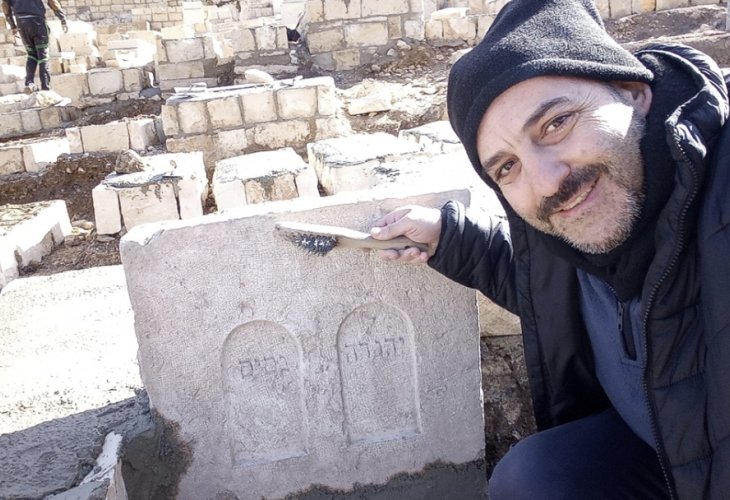How My Family's Graves Were Discovered: A First-Hand Account
Following an article about Rabbi Ackerman's efforts in uncovering ancient graves, here's a first-hand account of discovering my family's graves.

When Luna Nissim died (in 1942), she was buried at the Mount of Olives (like her husband and many from the Nissim family). My late grandmother always told that her mother was buried next to the Absalom's Tomb, and said that since 1967, after the Six-Day War, access to the graves at the Mount of Olives was permitted, after 19 years of Jordanian control. To the astonishment of my grandmother and her sisters, when they arrived at the Mount of Olives in 1967, they did not find their mother's grave! The whole area was destroyed, and many graves were desecrated and destroyed by the Jordanians during their time there. She always mentioned with sadness that there was no place for her and her family to cry over their mother who passed away, and not even a grave location to pray for her.<\/p>
During my research, I contacted the dear Rabbi Mordechai Motula, who performs a sacred task in mapping the cemetery of the Mount of Olives. With his kind help, I found several graves of other Nissim family members (such as the two wives of the esteemed Rabbi Shmuel Nissim, of blessed memory, and others). Recently, in December 2019, I received an email from Rabbi Motula informing me that excavations were taking place in the same area destroyed by the Jordanians and paved with a road, and many graves are being discovered below the surface. Although my profession is a juggler and magician, I could not have wished or prayed for such a miracle!
He updated that in the coming week, following his records, they will reach the section where Luna Nissim and two of her sons are buried. The reason she was buried above Absalom's Tomb (and not in the Sephardic Buraq section like the other Nissim family ancestors) is that her two sons who died at a relatively young age were buried there. My heart pounded with the amazing news! Previously, Rabbi Motula had always told me that according to his records, the area of her burial was approximately known, but it could not be precisely determined until an excavation took place in that area.<\/p>
I was pleased with the update and went every single day that week to the Mount of Olives to document, photograph, and commemorate this anticipated moment.<\/strong> And behold, a few days later, at the beginning of January 2020, the graves of Luna Nissim and one of her sons, Yehuda Nissim, were uncovered. Another grave of her additional son, Moshe Nissim, has not yet been definitively identified, but Luna's grave itself was certainly identified thanks to Rabbi Motula's records and Rabbi Ackerman's reporting of the burial findings on the ground!
I must commend and highlight the great mitzvah and the amazing and delicate work in revealing the graves by Rabbi Moshe Ackerman from the "Atara Kedisha" organization. I will seize this opportunity to thank Rabbi Ackerman heartfeltly for dedicating his time, allowing me to film and document the entire graves revelation process of my family.<\/p>
A miraculous event occurred, one morning, when I received a phone update from Rabbi Ackerman, telling me that during the excavation around the graves exposed from the previous day, a part of the original grave was found with an engraving of a Torah scroll, and inside it, the inscription of the name "Yehuda Nissim." This inscription helped to certainly identify the grave of Yehuda Nissim—the son of Luna Nissim (who died from an infection due to a bite from one of the neighbors...). His brother, Moshe Nissim, died from a fall while riding a horse (I found the obituary regarding his death in a newspaper from 1926). I will emphasize that most of the graves in the row of their graves were found without any sign or headstone—only the concrete base of the graves.<\/strong> I was very sorry that there was no longer a trace of the headstones erected for my family members...
And thus, thanks to the actions of Rabbi Ackerman and Rabbi Motula in mapping and uncovering the graves at the Mount of Olives, the grave of Luna Nissim, my grandmother's mother, was uncovered—a burial place that wasn't known for 72 years—from 1948 until 2021!
I am happy to be the descendant of the Nissim family who participated in this special and historic moment that I will remember forever! During August 2020, after raising funds from Luna Nissim’s descendants who wanted to fulfill the mitzvah and erect a memorial for the exposed graves, I managed to restore the gravestones of Luna Nissim and her son Yehuda Nissim (using the original stone found from his grave). Truly a family of "Nissim"...
This is my personal story, and in recent years, I have also strengthened and approached my faith more and more, partly due to the family research and discovering its roots. I am happy to acknowledge that without the unique actions of Rabbi Motula and Rabbi Ackerman, many families would not have had the opportunity to renew the memorials of their loved ones at the Mount of Olives and restore the crown to its former glory! Thank you! Thank you! Thank you!
Luna Nissim's grave under the rounded pillar before excavation:<\/p>

Part of Yehuda Nissim’s original grave exposed with his name inscribed on it:<\/p>


The establishment of the gravestones for Luna Nissim and her son Yehuda Nissim:<\/p>

<\/p>


